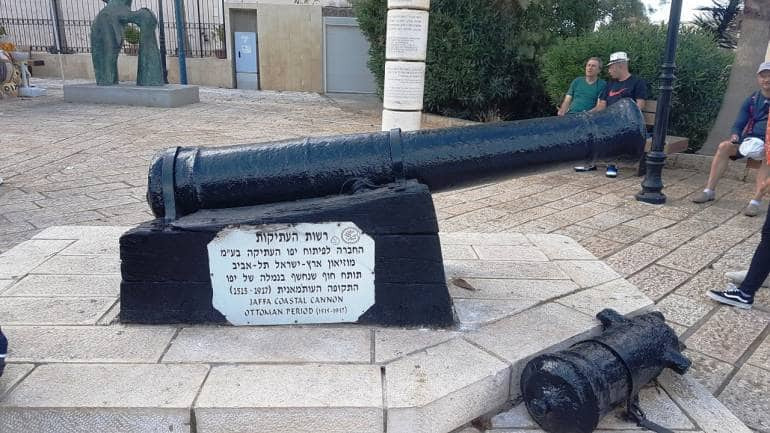
Jaffa is possibly the world's oldest port city, at 4,000 years old. And as is the case with old port cities the world over, it became a centre for commerce as well as culture. There are churches, art galleries, museums, street kiosks selling souvenirs, a clock tower, alleys with their own stories and a bustling port at every turn.
If you find yourself in Jaffa, start from the view point where a cannon painted in black is hard to miss. The Ottomans imported cast iron cannons in the early 18th century, to bolster Jaffa's security against Bedouin raids on land and attacks by pirates who came via the sea. The cannons were discovered during excavations at Jaffa Port.
 Cast iron cannon in Old Jaffa. (Photo: Khusheed Dinshaw)
Cast iron cannon in Old Jaffa. (Photo: Khusheed Dinshaw)
St Peter’s Church is an important landmark of the neighbourhood. The current seafacing Church was completed in 1894. As per the New Testament, St Peter the Apostle stayed in Jaffa at the home of Simon who was a tanner and then proceeded to the coast of Caesaria to spread the message of Jesus Christ.
Close to St Peter’s Church is the Zodiac Fountain where excavations were done in 2010. Remains found date back to the Ottoman Period. Legend has it that there used to be a wishing well at the location of the Zodiac fountain. It is believed that if you want a wish to be granted, you put a coin in the well.
The alleys of this neighbourhood are a treasure trove of art galleries and museums. Among the most popular today is the Ilana Goor museum which is the home of artist Ilana Goor and also showcases her work. The multi-storeyed building dates back to the 18th century and each room has its own distinct identity. The rooftop has sculptures while other rooms display art, contemporary paintings, modern furniture and ethnic jewellery. Some of the exhibits also educate visitors about various cultures like the butterfly masks from Burkina Faso which were used in dancing by the Do society.
Tucked in another quaint alley is the colourful art studio of Betty Rubinstein whose work mostly reflects expressionism.
Another pathway leads to a Synagogue. In 1740, the first Jewish hostel was constructed here. It had a synagogue which was re-opened in 1948 and is still used as a Jewish house of worship.
Old Jaffa also attracts patrons of theatre as it houses a fringe theatre known as Hasimta where experimental performances are conducted. Tucked in another alley is the Greek Orthodox Monastery. It gets its name from the Archangels Michael and Gabriel.
Dating back to the 17th century, there is a Church on the premises where mass is conducted on the weekends in two languages-Romanian and Russian. Entry to the Monastery is through a passage lined with stone walls and burning candles. It is common to find the priest clad in black robes busy at the altar.
Exploring the pathways of Jaffa, one comes across the mysterious room of Adina Plastelina. The room has a table on which knick-knacks are for sale while the walls have showcases with jewellery on offer. The modern looking gallery inside the room holds ties to the history of Old Jaffa. When it was decided to renovate it a few years ago, during the refurbishment, at the level of the sand mound, an old structure made of limestone was discovered. The artefacts discovered during this renovation beneath the ground gave insight into the lives and times of the locals and go far back to the late Bronze Age.
 Old Jaffa (Photo by Boris Kuznetsov via Wikimedia Commons 3.0)
Old Jaffa (Photo by Boris Kuznetsov via Wikimedia Commons 3.0)
Walking around, another pathway opens onto Jaffa Port which is one of the world’s oldest ports. It has been operating since almost 4,000 years. Even though the port was expanded sometime in the 19th century, large steamships could still not be anchored here. These used to dock at sea and their passengers and cargo were brought to land via boats.
The port is a scenic spot with the turquoise water offsetting the brown stone buildings. Tourists like to sip on freshly squeezed pomegranate juice while taking in the view of the gentle lapping of the waves against the pier.
Discover the latest Business News, Sensex, and Nifty updates. Obtain Personal Finance insights, tax queries, and expert opinions on Moneycontrol or download the Moneycontrol App to stay updated!
Find the best of Al News in one place, specially curated for you every weekend.
Stay on top of the latest tech trends and biggest startup news.